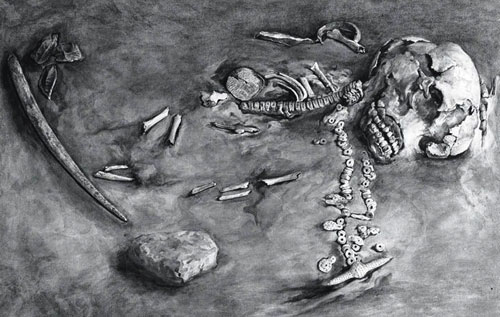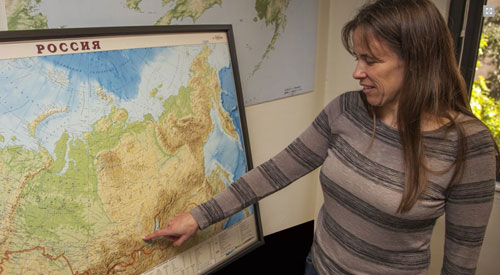
DNA found in Russia suggests first Americans walked through Siberia to Alaska
November 21, 2013
The DNA work performed on the boy is the oldest complete genome of a human sequenced so far, the study shows. Also found near the boy’s remains were flint tools, a beaded necklace and what appears to be pendant-like items, all apparently placed in the burial as grave goods.
Remains of 24,000 year-old Mal'ta Boy
“Though our results cannot speak directly to this debate, they do indicate Native American ancestors could have been in Beringia - extreme northeastern Russia and Alaska - any time after 24,000 years ago and therefore could have colonized Alaska and the Americas much earlier than 14,500 years ago, the age suggested by the archaeological record.” Kelly Graf, assistant professor in the Center for the Study of First Americans and Department of Anthropology at Texas A&M, is part of an international team spearheaded by Eske Willerslev and Maanasa Raghaven from the Centre for GeoGenetics at the University of Copenhagen, Denmark and additional researchers from Sweden, Russia, United Kingdom, University of Chicago and University of California-Berkeley. Their work, funded by the Danish National Science Foundation, Lundbeck Foundation, and the National Science Foundation, is published in the current issue of Nature magazine.
Texas A&M Professor Kelly Graf points to a map of
Instead, both the mitochondrial and nuclear genomes of MA-1 indicate that he was related to modern-day western Eurasians. This result paints a picture of Eurasia 24,000 years ago which is quite different from the present-day context. The genome of MA-1 indicates that prehistoric populations related to modern western Eurasians occupied a wider geographical range into northeast Eurasia than they do today. The most significant finding that the MA-1 genome reveals is its relation to modern Native Americans. This relative of present-day western Eurasians shows close affinity to modern Native Americans, but surprisingly not to East Asians who are regarded as being genetically closely related to Native Americans. Furthermore, the team finds evidence that this genetic affinity between MA-1 and Native Americans is mediated by a gene flow event from MA-1 into the First Americans, which can explain between 14-38% of the ancestry of modern Native Americans, with the remainder of the ancestry being derived from East Asians. Supported by numerous reasons against these signatures being caused by contamination from modern DNA sources or from post-Columbian admixture (post 1492 AD), the study concludes that two distinct Old World populations led to the formation of the First American gene pool: one related to modern-day East Asians, and the other a Siberian Upper Palaeolithic population related to modern-day western Eurasians. "The result came as a complete surprise to us. Who would have thought that present-day Native Americans, who we learned in school derive from East Asians, share recent evolutionary history with contemporary western Eurasians? Even more intriguingly, this happened by gene flow from an ancient population that is so far represented only by the MA-1 individual living some 24,000 years ago", says Professor Eske Willerslev from the Centre for GeoGenetics who led the study. Additionally, results from a second south-central Siberian from Afontova Gora-2 site are presented in order to address human occupation of the region during and after the Last Glacial Maximum (LGM; ca. 26,000 to 19,000 years ago), a climatically cold period when glacial ice sheets extended to their maximum range. At approximately 17,000 years ago, this post-LGM individual demonstrates similar genomic signatures as MA-1, with close affinity to modern western Eurasians and Native Americans and none to present-day East Asians. This result indicates that genetic continuity persisted in south-central Siberia throughout this climatically harsh period, which is a significant consideration for the peopling of Beringia, and eventually the Americas some 15,000 years ago. Dr. Pontus Skoglund from Uppsala University, and one of the lead authors of the study, explains, "Most scientists have believed that Native American lineages go back about 14,000 years ago, when the first people crossed Beringia into the New World. Our results provide direct evidence that some of the ancestry that characterizes Native Americans is at least 10,000 years older than that, and was already present in Siberia before the last Ice Age." Professor Kelly Graf from the Center for the Study of the First Americans (Texas A&M University), who together with Professor Willerslev did the sampling, adds, "Our findings are significant at two levels. First, it shows that Upper Paleolithic Siberians came from a cosmopolitan population of early modern humans that spread out of Africa to Europe and Central and South Asia. Second, Paleoindian skeletons with phenotypic traits atypical of modern-day Native Americans can be explained as having a direct historical connection to Upper Paleolithic Siberia." As such, results from this study contribute a major leap forward for resolving the peopling of the Americas.
Graf and Willerslev conceived the project and traveled to the Hermitage State Museum in St. Petersburg, Russia, where the remains are now housed to collect samples for ancient DNA. The skeleton was first discovered in the late 1920s near the village of Mal’ta in south-central Siberia, and since then it has been referred to as “the Mal’ta child” because until this DNA study the biological sex of the skeleton was unknown. “Now we can say with confidence that this individual was a male” says Graf. Graf helped extract DNA material from the boy’s upper arm and “the results surprised all of us quite a bit,” she explains. “It shows he had close genetic ties to today’s Native Americans and some western Eurasians, specifically some groups living in central Asia, South Asia, and Europe. Also, he shared close genetic ties with other Ice-Age western Eurasians living in European Russia, Czech Republic and even Germany. We think these Ice-Age people were quite mobile and capable of maintaining a far-reaching gene pool that extended from central Siberia all the way west to central Europe.” Another significant result of the study is that the Mal’ta boy’s people were also ancestors of Native Americans, explaining why some early Native American skeletons such as Kennewick Man were interpreted to have some European traits. “Our study proves that Native Americans ancestors migrated to the Americas from Siberia and not directly from Europe as some have recently suggested,” Graf explains. “What we need to do is continue searching for earlier sites and additional clues to piece together this very big puzzle.”
Source of News:
E-mail your news &
photos to editor@sitnews.us
|
||

